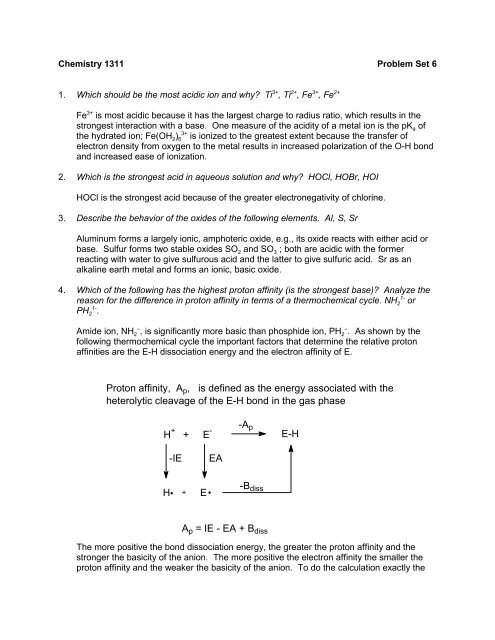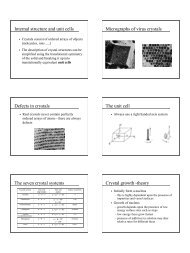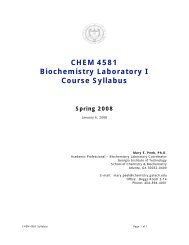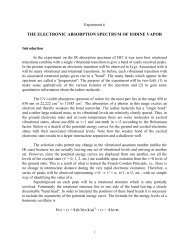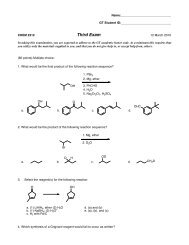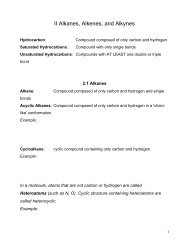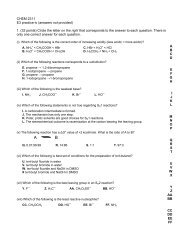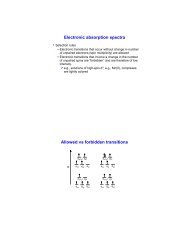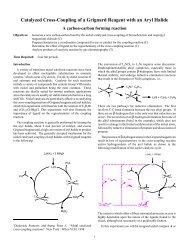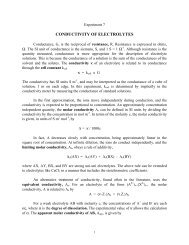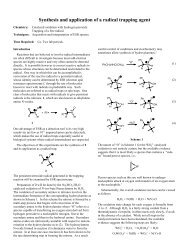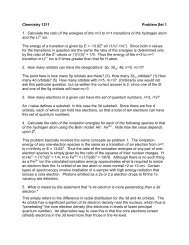Solutions to Problem Set #6
Solutions to Problem Set #6
Solutions to Problem Set #6
- No tags were found...
You also want an ePaper? Increase the reach of your titles
YUMPU automatically turns print PDFs into web optimized ePapers that Google loves.
Chemistry 1311 <strong>Problem</strong> <strong>Set</strong> 61. Which should be the most acidic ion and why? Ti 3+ , Ti 2+ , Fe 3+ , Fe 2+Fe 3+ is most acidic because it has the largest charge <strong>to</strong> radius ratio, which results in thestrongest interaction with a base. One measure of the acidity of a metal ion is the pK a ofthe hydrated ion; Fe(OH 2 ) 6 3+ is ionized <strong>to</strong> the greatest extent because the transfer ofelectron density from oxygen <strong>to</strong> the metal results in increased polarization of the O-H bondand increased ease of ionization.2. Which is the strongest acid in aqueous solution and why? HOCl, HOBr, HOIHOCl is the strongest acid because of the greater electronegativity of chlorine.3. Describe the behavior of the oxides of the following elements. Al, S, SrAluminum forms a largely ionic, amphoteric oxide, e.g., its oxide reacts with either acid orbase. Sulfur forms two stable oxides SO 2 and SO 3 ; both are acidic with the formerreacting with water <strong>to</strong> give sulfurous acid and the latter <strong>to</strong> give sulfuric acid. Sr as analkaline earth metal and forms an ionic, basic oxide.4. Which of the following has the highest pro<strong>to</strong>n affinity (is the strongest base)? Analyze thereason for the difference in pro<strong>to</strong>n affinity in terms of a thermochemical cycle. NH 2 1- orPH 2 1- .Amide ion, NH 2 – , is significantly more basic than phosphide ion, PH 2 – . As shown by thefollowing thermochemical cycle the important fac<strong>to</strong>rs that determine the relative pro<strong>to</strong>naffinities are the E-H dissociation energy and the electron affinity of E.Pro<strong>to</strong>n affinity, A p , is defined as the energy associated with theheterolytic cleavage of the E-H bond in the gas phase-AH + + E - pE-H-IEEAH+E-B dissA p = IE - EA + B dissThe more positive the bond dissociation energy, the greater the pro<strong>to</strong>n affinity and thestronger the basicity of the anion. The more positive the electron affinity the smaller thepro<strong>to</strong>n affinity and the weaker the basicity of the anion. To do the calculation exactly the
ond dissociation energies of the N-H and P-H bonds and the electron affinities of NH 2and PH 2 are needed. However, if one assumes that the differences in these quantities areabout the same as the differences in the average bond dissociation energies (386 kJ mol -1for NH 3 and 322 kJ mol -1 for PH 3 ) and electron affinities of the elements (-7 kJ mol -1 for Nand 72 kJ mol -1 for P) then it is possible <strong>to</strong> understand the reason for the stronger basicityof NH 2 -1 . (Note that these values are given in tables in the handouts.) From these dataone sees that since the difference in E-H bond strength is greater than the difference inelectron affinity, NH 2 should be the stronger base.5. Of the following anions, which has the strongest conjugate acid? Why? ClO 1- , ClO 2 1- ,ClO 3 1- , ClO 41-ClO 4 – is the weakest base because of the high formal oxidation state of the chlorine, whichwithdraws electron density from the oxygens; therefore, it has the strongest conjugate acid.6. Which of the following anions is most basic, which is least basic? CH 3 – , C 4- , F – , I –The most basic ion is clearly C 4- . Since methane is much less acidic than either HF or HI,its conjugate base must necessarily be more basic. Obviously further depro<strong>to</strong>nation ofmethane <strong>to</strong> give the methide anion produces an even more basic species. Iodide ion is theleast basic, which follows from the fact that its conjugate acid is more acidic than HF.7. Write a balanced chemical reaction that can account for the indicated observation or thatdescribes the chemical reaction that will occur when the indicated operation is performed.Note that each of these reactions involves the reaction of an acid with a base.a) Reaction of gaseous HF and gaseous SO 3 combine <strong>to</strong> give a liquid that is a strongBronsted acid.HF (g) + SO 3 = HOSO 2 Fb) Iodine, a nonpolar substance is insoluble in water, but dissolves in aqueous I 1- solution.I – (aq) + I 2(s) = I 3–(aq)c) Carbon dioxide dissolves in a large excess of aqueous OH 1- .CO 2(g) + 2 OH – (aq) = CO 32-(aq) + H 2 Od) Addition of alumina, Al 2 O 3 , <strong>to</strong> a strongly basic aqueous solution results in a decrease inthe hydroxide concentration.Al 2 O 3(s) + 2 OH – (aq) + 3 H 2 O = 2 Al(OH) 4–(aq)e) Calcium oxide is treated with aqueous HCl.CaO (s) + 2 H 3 O + (aq) = Ca 2+ + 3 H 2 O (liq)f) A gas is evolved when acetic acid (CH 3 CO 2 H) is added <strong>to</strong> a stirred suspension of lithiumdeuteride (LiD) in THF (THF is an inert solvent)
LiD (s) + CH 3 CO 2 H = Li + (sol) + CH 3 CO 2–(sol) + HD (g)g) NaH, which is insoluble in THF (THF is an inert solvent) alone, dissolves in a solution oftriethylboron, B(CH 2 CH 3 ) 3 , in THF.NaH (s) + B(CH 2 CH 3 ) 3(sol) = Na + (sol) + HB(CH 2 CH 3 ) 3–(sol)h) A gas is evolved when calcium phosphide (Ca 3 P 2 ) is treated with water.Ca 3 P 2(s) + H 2 O = 3 Ca 2+ (aq) + 6 OH – (aq) + 2 PH 3(g)8. Define solvent leveling of acid and base strengths and give an example of the leveling ofan acid or a base.The strongest acid and base that can exist in a given solvent are the conjugate acid andbase of the solvent. For example in liquid ammonia the strongest acid that can exist isNH 4 + and the strongest base is NH 2 – . Although acetic acid is clearly a stronger acid thanNH 4 + when acetic acid is dissolved in liquid ammonia the following reaction takes place:CH 3 CO 2 H + NH 3 = NH 4 + + CH 3 CO 2 – . The acid that is present after this reaction is theammonium ion; the acidity of the stronger acetic acid has been “leveled” <strong>to</strong> that of theammonium ion.9. The anion [H 3 B-H-BH 3 ] 1- has an electron deficient B-H-B interaction. Draw the energy leveldiagram for the three molecular orbitals that would be formed assuming interaction of twoB sp 3 hybrid orbitals and a hydrogen 1s orbital and indicate the electron occupancy of eachorbital. Make a drawing of each molecular orbital and indicate whether it is bonding,nonbonding or antibonding.antibondingBHnonbondingbonding10. Classify each of the following halides as (i) predominantly a Lewis acid, (ii) predominantly aLewis base, (iii) neither.a) CF 4 Neither; carbon is incapable of expanding its valence shell and fluorine is <strong>to</strong>oelectronegative <strong>to</strong> effectively donate electron density <strong>to</strong> a base.b) AgI Acidic; although halide is normally basic, when tied up with silver its basicity islargely lost. Silver on the other hand will react with bases such as ammonia, which willcause dissolution of the insoluble salt.
c) KF Basic; can act as a fluoride ion donor. Note the difference between this salt and AgI.d) SiCl 4 Acidic; silicon can expand its valence shell and bind a variety of bases includingchloride or pyridine.e) PF 3 Basic; however, because of the very electronegative fluorine substituents thismolecule is only a weak base <strong>to</strong>ward pro<strong>to</strong>ns but it is a strong ligand <strong>to</strong>ward low-valentmetals.f) SF 6 Neither; the coordination number of six is rarely exceeded so that this moleculedoes not act as a Lewis acid and the high electronegativity of fluorine does not allow for it<strong>to</strong> act as a base.g) PCl 5 Acidic; this compound reacts with a wide variety of Lewis bases <strong>to</strong> form adducts.h) (CH 3 ) 3 N Basic; the lone pair on nitrogen is used <strong>to</strong> form bonds with a variety of Lewisacids including PCl 5 or SiCl 4 above.11. Dissect the following molecules or ions in<strong>to</strong> the acid and base that could have been used intheir formation. H 2 CO 3 (two answers), BH 4 1- , (CH 3 ) 3 NSO 2 , Ni(OH 2 ) 6 2+ (two answers)H + , HCO 3 – or H 2 O, CO 2 ; BH 3 , H – ; SO 2 , N(CH 3 ) 3 ; H + , [Ni(OH 2 ) 5 OH] + or [Ni(OH 2 ) 5 ] 2+ , OH 2


